By guest writer
Ed Caryl
Arctic stations near heat sources show warming over the last century. Arctic stations that are isolated from manmade heat sources show no warming. The plots of “isolated stations” and “urban stations” below clearly illustrate the differences.
All the GISS temperature anomaly maps show the Arctic warming faster than the rest of the globe, especially northern Alaska and Siberia, but the satellite data shows a different pattern. See the 2 charts for 2009 that follow. The GISS surface map:
The baseline period selected for the GISS surface temperature chart is the 1933 to 1963 Atlantic Multi-decadal Oscillation (AMO) warm period. This period more closely matches today’s temperatures than the default 1951 to 1980 cool period that GISS uses. The satellite data uses the average over the satellite period since 1979, the modern warm period.
The satellite data show cooling in central Siberia, similar to the surface anomaly map, and very little warming for most of Alaska. It also shows cooling for the Antarctic Peninsula, where the surface map shows warming. But there is a scattering of hot grid squares across the HISS surface station map for the Arctic. So what is going on?
I selected the stations that correspond to those warm grid squares, as well as other stations in the same latitudes. In this age of everyone carrying a camera posting all photos on the Internet, there is a lot of information available on these stations. For some I could locate the Stevenson screens, for most I’ve found pictures of the surroundings, while others have investigated many of these sites already, and so links to that research are included. I downloaded the raw temperature data from GISS for 24 stations closest to the North Pole, which are all classified as “rural”.
“Urban” Arctic Stations
Contrary to GISS claims, many of these stations are actually not “rural” with respect to their siting quality. Many are at airports associated with sizable towns or research stations with sizable staff and infrastructure. In the Arctic, any town of more than a few families can be a large heat source. In the case of many towns in Russian Siberia, “central heating” takes on a whole new meaning. These towns have a central power plant that provides electricity and steam heat to the whole town. Large pipes, both insulated and un-insulated, carry steam, water, and sewage, up and down the streets to and from each dwelling. These pipes cannot be buried because of the permafrost, so they are elevated, and at street crossings are elevated 4 or 5 meters. The temperature differential between these pipes and the surrounding air can be 140° C in winter, and even more for a pressurized system.
But GISS applies the same Urban Heat Island (UHI) criteria to all stations globally, regardless of the latitude or average temperature. They look at the satellite night brightness and population to judge whether urban or rural. By GISS criteria, all the stations in the high Arctic are rural; there are no corrections for UHI.
But let’s look at each of these “urban” locations. Each name is also a link to the GISS surface temperature raw data.
List of Urban Arctic Stations (see the annex at the end of this post for details on each station)
1. Kotzebue, Ral (66.9 N,162.6 W), Alaska
2. Barrow/W. Pos (71.3 N,156.8 W) Alaska
3. Inuvik (68.3N, 133.5W) Inuvik, Canada
4. Cambridge Bay (69.1 N,105.1 W) Nunavut, Canada
5. Eureka, N.W.T. (80.0 N,85.9 W), Canada
6. Nord Ads (81.6 N,16.7 W Northeast Greenland
7. Svalbard Luft (78.2 N,15.5 E), Norway
8. Isfjord Radio (78.1 N,13.6 E), Norway
9. Gmo Im.E.T.(80.6 N,58.0 E), Russia
10. Olenek (68.5 N,112.4 E), Russia
11. Verhojansk (67.5 N,133.4 E), Russia
12. Cokurdah (70.6 N,147.9 E), Russia
13. Zyrjanka (65.7 N, 150.9 E), Russia
14. Mys Smidta (68.9 N,179.4 W), Russia
15. Mys Uelen (66.2 N,169.8 W), Russia
The following graphic is a temperature chart for 10 of the above stations (5 of the shorter ones were left out to avoid over-crowding). All are warming, some faster than others. Barrow, for which we have the UHI study, is not the fastest warming.
Isolated Stations
Now let us look at the isolated stations, which are located at similar latitudes like the above “urban” stations. One important thing to note about these isolated stations – there is limited electrical power, and so incandescent light bulbs in the Stevenson screens is unlikely. Detailed descriptions of these stations are listed in the annex at the end of this report.
16. Alert,N.W.T.(82.5 N,62.3 W), Canada
17. Resolute,N.W. (74.7 N,95.0 W), Canada
18. Jan Mayen (70.9 N,8.7 W), Norway
19. Gmo Im.E. K. F (77.7 N, 104.3 E), Tamyr Peninsula, Russia
20. Ostrov Dikson (73.5 N,80.4 E, Russia
21. Ostrov Kotel’ (76.0 N,137.9 E), Russia
22. Mys Salaurova (73.2 N,143.2 E), Russia
23. Ostrov Chetyr (70.6 N,162.5 E), Russia
24. Ostrov Vrange (71.0 N,178.5 W) , Russia
Now here is the chart of the temperatures of these isolated stations, not subjected to manmade structures or heat sources.
Note that most of the trends are flat or decreasing. Only Resolute and Ostrov Vrange are increasing slightly. Both of those might be slightly influenced by UHI. The longest records clearly show warming in the late 1930’s and 40’s, and cooling in the 1960’s, and none show a hockey stick. The GISS data for Alert ends in 1991, though the weather station is still there, and still reporting. Data for Mys Salaurova and Ostrov Chetyr also ends at about that time, probably due to the fall of the Soviet Union.
Here is an average of all the isolated stations:
Note that the peak-to-peak trend is nearly zero. The linear trend is about 0.4°C/century, but the R2 value (the statistical significance for the trend) is very low, 0.023.
Here is a plot of the AMO versus the average temperature of the isolated stations.
The temperature as measured at stations isolated from any UHI is simply tracking the AMO.
Looks like an awfully good fit. There is very little, if any, global warming. We need to wait until the bottom of the next AMO cycle to get a decent reading of global temperature change. That will be in about 2050 if the AMO cycles as it has since 1850.
———————————————————————————————-
Annex – station descriptions
The “urban” stations, nos. 1-15
1. Kotzebue, Ral (66.9 N,162.6 W),
2. Barrow/W. Pos (71.3 N,156.8 W)
These towns are of similar size, and are growing at the same rate. In 1940, both towns had a population of 400. In 1980 both had just over 2000 population, and now they both have over 3000 people. Both have airports of sufficient size to handle multi-engine turboprop and small jet aircraft, and both are served daily by regional airlines. Kotzebue is on a peninsula and the airport is across the middle of the peninsula, somewhat restricting the growth of the town. Barrow has somewhat the same problem due to a series of small ponds around the town and the airport. Barrow was studied for UHI effects in 2003. That paper was in the International Journal of Climatology here. That paper describes the UHI average temperature increase in winter as 2.2°C compared to the surrounding hinterland. GISS data indicates that Barrow average temperature has increased over the years as population has increased. (See below, or click on link above.)
Source: http://en.wikipedia.org/wiki/File:BRW-g.jpg
Source: http://en.wikipedia.org/wiki/File:OTZ-g.jpg
The Barrow NWS station (Stevenson Screen) is here. On the airport picture, it is at the base of the rotating beacon tower. Kotzebue NWS station is not visible in published pictures.
3. Inuvik (68.3N, 133.5W)
Inuvik is a relatively new town, begun in 1954. The population as of 2006 has grown to about 3500 people. Because it is a “planned” community in the arctic, built on permafrost, the water and sewage infrastructure is above ground in heated and insulated “utilidors”, like the heating systems in Siberia. The weather station, from weather reports, Google Earth and Google Street View, appears to be at the airport, in a compound just north of the entrance.
4. Cambridge Bay (69.1 N,105.1 W), Cambridge Bay, Nunavut, Canada
There is a Wikipedia picture of Cambridge Bay here. The population has grown from just a few people in the 1940’s to about 1500 today. It also has an airport with daily regional airline service.
5. Eureka, N.W.T. (80.0 N,85.9 W), Eureka, N. W. T., Canada
There are the only four stations at or north of 80° latitude, Eureka, Alert, Nord and Krenkle (Gmo. I.M.ET). Only Eureka has an unbroken temperature record to the present date, and it begins in 1947. The population at Eureka has
never been high. In winter it has always been 4 or 5 men. In summer, the population increases to as high as 20. The station infrastructure though, has expanded through the years. Each year, some of those 20 workers add or expand buildings. In the beginning, it was one or two buildings, with water and sewage handled in tanks and barrels internal to the buildings. The Stevenson screen was originally placed where the blue New Main Complex building is now. When that was built, the Meteorological instruments were moved to the current location. Over time, the water supply, plumbing, and sewage treatment was upgraded and the outfall pipe installed. It, of course, must be heated to facilitate flow to the sewage lagoon. All the water pipes exposed to the outdoors must be heated to prevent freezing.
Image from a recent article by Anthony Watts on WUWT here.
6. Nord Ads (81.6 N,16.7 W, Northeast Greenland
Nord is the furthest north inhabited place on earth, on the Northeast coast of Greenland. It was built in the period from 1952 to 1956 as an emergency airfield for aircraft operating out of Thule. Access is impossible by sea because the sea ice never moves away from the coast there. Legend has it that “Blowtorch” Murphy, a mythic arctic construction worker, scraped the first runway, using a parachute dropped caterpillar tractor after he himself parachuted onto the site. His nickname came from his habit of wearing a lit blowtorch hanging from his waistband on a wire; a lit blowtorch being somewhat useful when working outside when it’s 40° below zero.
There are about 40 buildings at Nord. Not all of them are continuously heated, but those near the Stevenson Screen are. The winter population is 5 or 6 men. More pictures here.
7. Svalbard Luft (78.2 N,15.5 E)
8. Isfjord Radio (78.1 N,13.6 E)
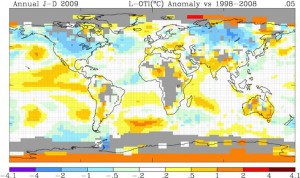 These two stations are only 47 kilometers apart. But data for both is fragmentary for 1976 and 1977, and there is no overlap. Svalbard Luft (airport) has been discussed on WUWT here and here, so I won’t cover it in detail here. Warwick Hughes has an article on Isfjord Radio here that makes the case for warming of Isfjord Radio due to moving of sea ice away from the islands in summer since 1912. Neither station in Svalbard shows on the anomaly map because there was no common station in both the base period and the anomaly period. Here’s a map with 1998 to 2008 as the base period where Svalbard appears.
These two stations are only 47 kilometers apart. But data for both is fragmentary for 1976 and 1977, and there is no overlap. Svalbard Luft (airport) has been discussed on WUWT here and here, so I won’t cover it in detail here. Warwick Hughes has an article on Isfjord Radio here that makes the case for warming of Isfjord Radio due to moving of sea ice away from the islands in summer since 1912. Neither station in Svalbard shows on the anomaly map because there was no common station in both the base period and the anomaly period. Here’s a map with 1998 to 2008 as the base period where Svalbard appears.
9. Gmo Im.E.T.(80.6 N,58.0 E)
This is the Krenkel meteorological station on Hayes Island, or Ostrov Kheysa in Russian, in the Franz Josef Land Archipelago, Russia. Link The station has been moved or re-built twice since it was established. It was moved from Hooker Island (article in German) in 1957/58. A fire destroyed the power station in 2000, and it was rebuilt in 2004 closer to the shoreline. The GISS record is from 1958 with a gap from 2001 to 2009. The population was as high as 200 during Soviet times, but is down to 4 or 5 now. The population and the temperature seem to track roughly during Soviet days, and the move in 2004 was to a warmer location. In the picture you can see the old buildings on the ridge in the distance. The red grid-square on the anomaly map above corresponds to this station.
Source: http://www.sevmeteo.ru/foto/15/88.shtml
10. Olenek (68.5 N,112.4 E)
This is the town of Ust’-Olenek, Russia.
Photo sources here and here.
The town doesn’t look like much, but notice the Tundra Buggies parked next to the Stevenson Screens. It is on the Laptev Sea, on the northern Siberia Coast, but on a peninsula on a south-facing beach. The buildings are right on the shore. The wide view above was taken from out on the ice. This is one of the few places in Russia that the Google Earth satellite view actually has enough resolution to see the Stevenson Screens. They are much too close to the heated building.
11. Verhojansk (67.5 N,133.4 E)
This is one of the “centrally heated” towns in Russian Siberia. The picture at the top of this article is of the Stevenson Screen. Verhojansk is called the “cold pole” of the earth, but the measurements are too warm by far. Look closely at the picture. Any photographer will note that the warm glow inside the Stevenson Screen is just the color temperature of an incandescent light bulb. If the steam heat in the town isn’t enough, or the cattle in the pole-barns in the distance, the heat from the light bulb will warm up the measurements. This site was covered on WUWT here and here. Anthony Watts notes that warm anomalies would appear and disappear in this part of Russia “as if a switch were thrown”. Could it be as simple as the switch on that light bulb?
12. Cokurdah (70.6 N,147.9 E)
Also spelled Chokurdakh. The population has been dropping in recent years, but was still over 2500 people in 2002. The town is sandwiched between the Indigirka River and the airport. There is no way to tell where the Stevenson Screen is located, but the infrastructure at the airport blends right into the town. See an aerial photo here.
13. Zyrjanka (65.7 N, 150.9 E) Also spelled Zyryanka, another steam-heated town in eastern Siberia, well inland. The airport is in this picture on the north edge of town, along the Kolyma riverbank. This airfield was built during WWII as a stop for aircraft being ferried to the Soviet Union from Alaska. A second airport 7 miles west of town was probably built during the cold war for the military. The town was established in 1931. The population is currently about 3500. During the Soviet Union it was up to 15,000.
14. Mys Smidta (68.9 N,179.4 W)
Or Cape Schmidt. John Daly wrote a bit about this location in 2000 (scroll way down in the article). The population was nearly 5000 in 1989, but has dropped since the fall of the Soviet Union. The population now is probably less than 1000. It is on the north coast of eastern Siberia, nearly at 180° longitude. The airbase there was built in 1954 as a staging base for any bombers headed for the U. S. It is still used by a regional airline.
15. Mys Uelen (66.2 N,169.8 W)
Or Cape Uelen. This is on the easternmost tip of Siberia, across Bering Strait from Kotzebue, Alaska. The current population is about 700 people. It is also centrally steam heated. The town is restricted by the geography, on a narrow spit sticking out into the sea, backed by a cliff on the landward side. The airport is a helipad. Cargo and fuel arrives by barge in the summer.
Below is a temperature chart for many of the above stations. All are warming, some faster than others. Barrow, for which we have the UHI study, is not the fastest warming.
16. Alert,N.W.T.(82.5 N,62.3 W), Alert, Canada
Alert, Canada has had a weather station since 1951. The population has never been more than 4 or 5 in the winter, with a higher population in the summer. I could not definitively locate the Stevenson screen, but there are two possibilities in this photo, both well away from the buildings.
THE ISOLATED STATIONS, NOS. 16-24
17. Resolute,N.W. (74.7 N,95.0 W)
The population of this Canadian station rose from zero prior to 1947, to 229 in 2006. There is an airport here, and the Stevenson Screen can be seen across the aircraft parking area from the airport terminal at the left edge of the photo.
18. Jan Mayen (70.9 N,8.7 W)
Pictures of the station are here, and a web site is here. The 18 people on the island live at Olonkinbyen, or Olonkin “City”. The meteorological station is 2.6 km away. The 4 people that work there live in Olonkin City. The Stevenson Screen appears to be well away from the station building, and the surroundings have probably not changed since the station was built.
19. Gmo Im.E. K. F (77.7 N, 104.3 E)
This is a Russian station on the Tamyr Peninsula at Cape Chelyuskin (Mys Chelyuskin). Nothing is visible at that location on the Google satellite view, but the resolution is very low. I found an article by Warwick Hughes dated September 2000 that speaks of cooling of the Tamyr Peninsula here. He also talks about “non-climate” warming of Verhojansk and Olenek.
20. Ostrov Dikson (73.5 N,80.4 E
This is Dickson Island in English. There is a town of Dikson 10 kilometers away on the mainland. The airport is on Dikson Island at the point called Ostrov Dikson on the map below. Pictures of the airport can be seen here. The town is pictured on this 1965 stamp.
Wikipedia link
21. Ostrov Kotel’ (76.0 N,137.9 E)
The full name is Ostrov Kotel’nyy. In English this is Kettle Island. The first documented explorer found a copper kettle, so obviously he was not the first person to find the island. A single building is barely visible on Google 3D mapsat the “settlement” known as Kalinina. This may be the meteorological station. No other signs of civilization can be seen on the whole island.
22. Mys Salaurova (73.2 N,143.2 E)
This also spelled Mys Shalaurova. The station is on the south-facing shore of an island and is visible on Google Earth here. There is a tide gauge, and the tide data is on that same page.
23. Ostrov Chetyr (70.6 N,162.5 E)
The full name is Ostrov Chetyrekhstolbovoy. This is a small island in the East Siberian Sea in the Medvezhy Island (Bear Island) group.
Map source here.
A description of the place is found: here. “A polar meteorological station and a radio station are situated on the shore of a small bay which indents the S side of the island.”
24. Ostrov Vrange (71.0 N,178.5 W)
This is otherwise known as Wrangle Island. It is about 125 kilometers off the Siberian coast on the 180th meridian. The weather station is at Ushakovskiy on a spit at Rogers Bay, at the right in this picture, well separated from the village. One building in the village is visible at the left. Link
The population in the village grew to as many as 180 people in the 1980’s, but when the Soviet Union dissolved, subsidies declined and the population moved to the mainland. The last villager was killed by a polar bear in 2003. The population at the weather station, when occupied, has always been 4 or 5.
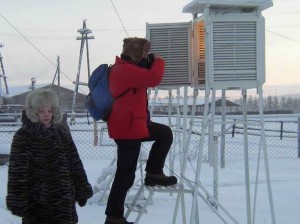
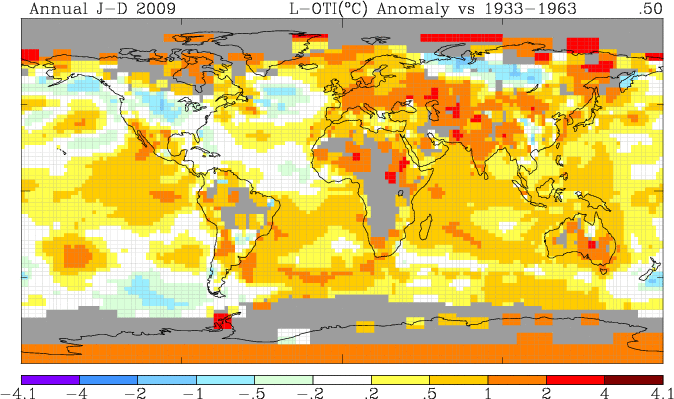
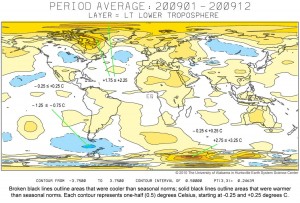
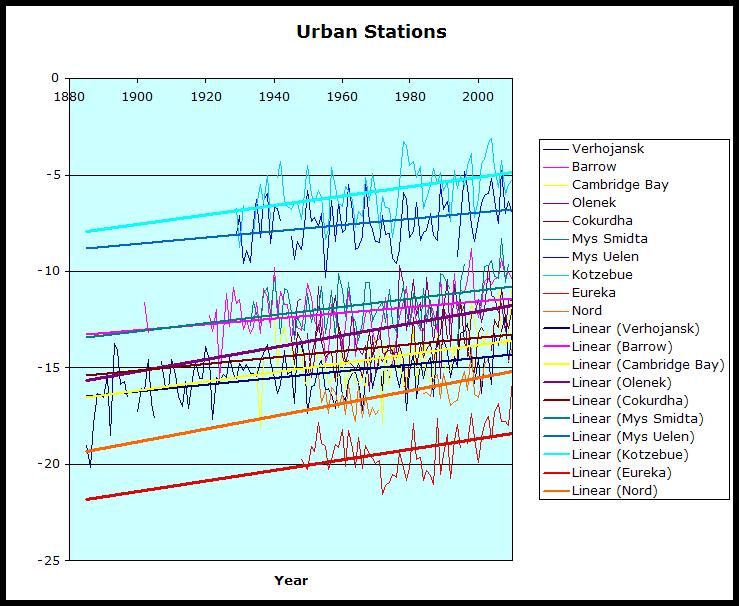
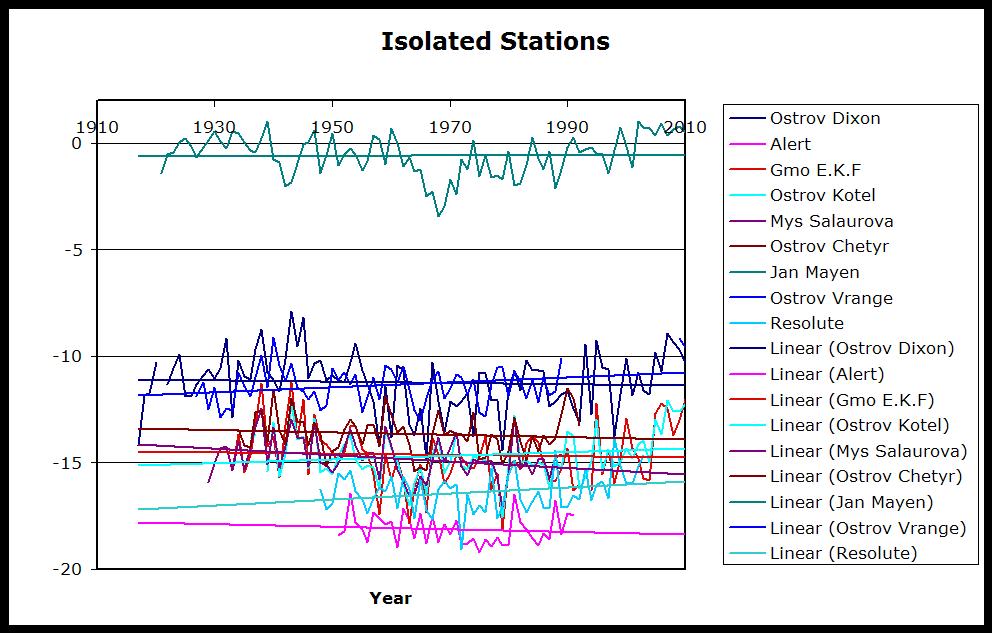
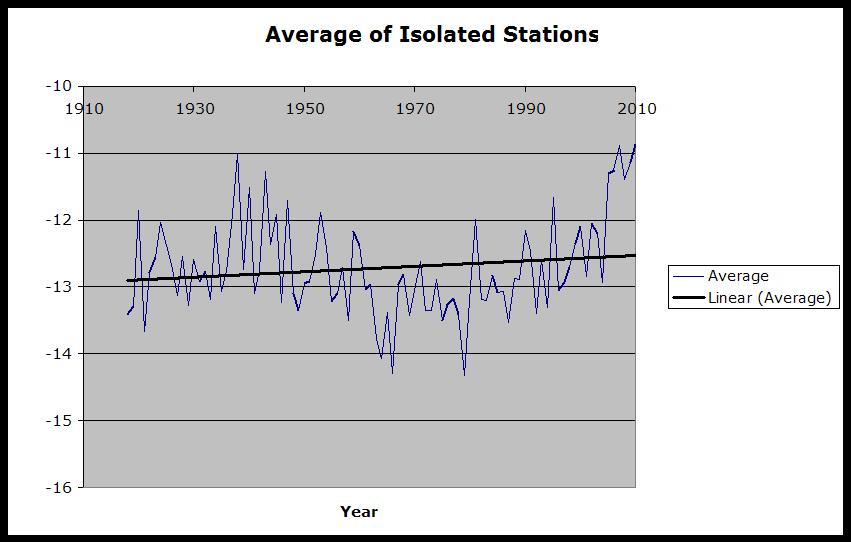
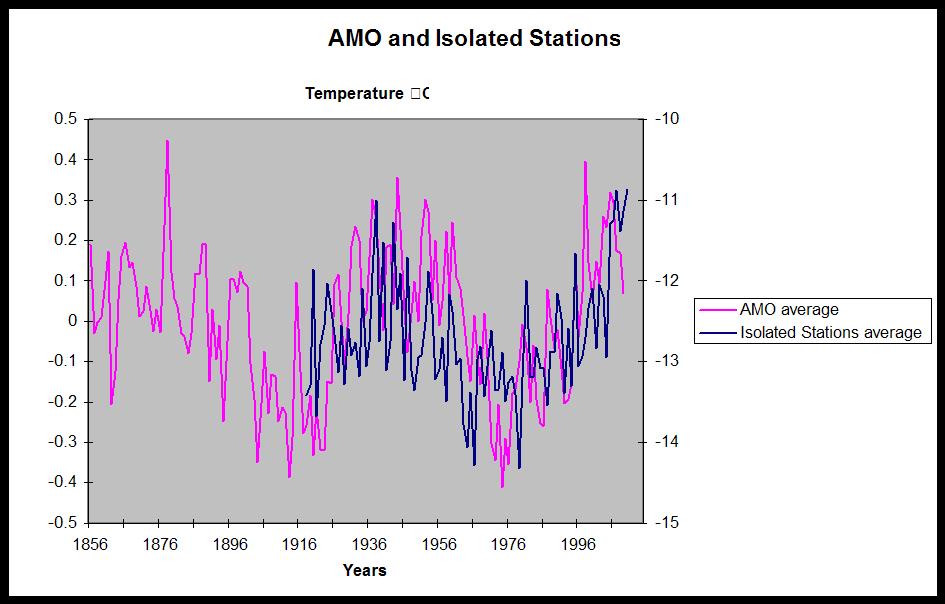
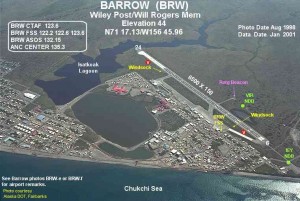
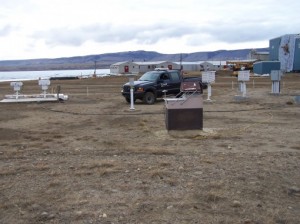







Great job Ed, I’m happy to be the one to post your analysis.
To me it’s evidence that Arctic climate change is strongly correlated with the AMO and that GISS results are messed up due to shoddy measurement methodology. Surely the plots of the isolated stations correlating with the AMO cannot be a coincidence.
Hey, this post is about my lovely region, Yakutia. I mean, a few stations you mentioned are located in Siberia’s Yakutia. Cool! Thanks! 🙂
—————————————————–
Reply: You’re more than welcome! Thanks for dropping by. Nice site you got there.
Maybe you could take some photos of the stations Ed mentions, if you’re close by.
We’d love to see some of them.
And if you’re into real cold, then you’ll be having fun this winter:
http://www.cpc.noaa.gov/products/people/wwang/cfs_fcst/images2/glbT850Sea.gif – PG
Re the reply by bolot – I attended a seminar some years ago in which the speaker claimed that the GISS temps in the Russian arctic went up following a sharp decline in the number of reporting weather stations in the area after the fall of the USSR. Is this true, did the number of reporting stations decline? If so, could it be that the jump in GISS temperature in your area was due to the loss of isolated, hard to get to stations with lower temps in favor of “urban” stations with warmer temps?
Also, what do you think of the suggestion by others of possible data reporting problems in which large negative temps are often routinely reported as positive in your area?
I am very interested to hear what someone from Siberia makes of all this.
Mind if I repost on WUWT?
Hi Anthony,
Sorry about the late moderation.
I’m a one-man show and I have to sleep sometimes.
FEEL FREE TO POST IT AT YOUR SITE.
We’d be thrilled. (So long it’s clear the source is NoTricksZone and with link).
Go for it!
Go ahead, Anthony. Get the word out.
Excellent article, thank you very much Ed Caryl, good job.
—————————————————
Reply: Having put this up on WordPress, and checking all the links and all, I know Ed must have invested a lot of time writing and researching this. -PG
It must have been a huge job and it’s much appreciated.
Great to see it back at WUWT which is some kind of a recognition for the quality of the article.
I congratulate you all.
Love the Power Point Presentation about the climate scam by Burt Rutan, you can download from this site.
http://rps3.com/Pages/Burt_Rutan_on_Climate_Change.htm
—————————————————-
Reply: Thanks Ron, I’ve read it, and it is indeed outstanding. -PG
Great analysis. Much as I hate anomalies (would much rather have real temperatures) they are useful and were the basis for matching the stations with differing temperatures here: http://diggingintheclay.wordpress.com/2010/09/01/in-search-of-cooling-trends/
There is a surprisingly good match in the wave pattern from the sites, but I wonder if it would be even better if using anomaly data. Since seeing the ‘sine wave’ pattern in the data I’ve wondered if it would be possible to disect out a UHI signal from geographically closely matched stations by subtracting the wave pattern.
It is so important to get this message out that, yes the Arctic is warming, but there is nothing unprecidented about it.
Joe Bastardi has published the link to this article on his blog.
http://www.accuweather.com/ukie/bastardi-europe-blog.asp?partner=accuweather
—————————————-
Reply: Cool! Joe is one of my favourites. Thanks Joe! – PG
Summer ends in the Arctic at -23-1°c
http://stevengoddard.wordpress.com/2010/09/21/summer-ends-in-the-arctic-at-23-1°c/
[…] attempting to keep A Light in Siberia as short as possible, the how and why of some points were not included. This led to some comments […]
[…] Guest writer Ed Caryl recently looked at 9 “rural” stations scattered over the Arctic: from Alaska, to Canada, to Northern Europe western Russia and Siberia and found Arctic temperatures follows the AMO, and not CO2. Read here A Light In Siberia. […]
Very good article, thankyou.
But Whoa! Resolute Bay Canada shouldn’t be in the “isolated” category. Population 229 in 2006 (http://www12.statcan.ca/census-recensement/2006/dp-pd/prof/92-591/details/page.cfm?Lang=E&Geo1=CSD&Code1=6204022&Geo2=PR&Code2=62&Data=Count&SearchText=Resolute&SearchType=Begins&SearchPR=01&B1=All&Custom=).
Definitely enough electrical power to light many Stevenson screens. (All will be powered by diesels, with fuel barged in during a few weeks in the summer, except Inuvik may have a pipeline from the Norman Wells area.)
(I use the term “High Arctic” for north of the mainland of NA. Cambridge, Eureka and Resolute are on islands, Inuvik is near the edge of the mainland near Alaska, with no large islands north of it, so it is reasonable to include it.)
It seems you also incorrectly have Eureka as “urban” despite saying it has a very small population, and is in isolated location (no nearby settlements).
Swap Eureka and Resolute and you’d be correct plus perhaps have even better match in your graphs. (Eureka has been detailed in the WWUT blog, with a case made that it has its own measuring error (a sort of mini “chinook” heating as well as being near water).)
And minor corrections:
– Inuvik is in the Northwest Territories
– Alert, Eureka, and Resolute Bahy are in Nanuvut (since the original NWT was split into NWT and Nanuvut)
(your lists of locations are not parsed correctly and has a few typos – walk through them).
And your remark about Nord being the furthest north seems at odds with its location relative to Alert.
All five Canadian locations in your list have sizeable runways capable of handling big fast transport aircraft, at least C-130s, in most cases heavy 727s capable of operating on gravel. Inuvik is paved, I think the others are still gravel surface.
Also, I am wary of using light visible from above for selection – efficient lighting would be directed low, especially near runways and aircraft approach paths, except perhaps to light pathways and the modest streets in such settlements. Depends on season I suppose – no patio activity in winter. 🙂 Might be skylights in buildings but I’ll bet they are closed at night. I’d also check for increased use of LED lighting, attractive due to the very high cost of electricity in most of those settlements.
Clarifying/Correcting:
Disregard comment that switching Eureka and Resolute would produce a better match in graphs, that needs detailed examination and is not relevant – the data is what it is, my essential point is the amount of activity and population as determining categorization.
The trend for Eureka is odd, though as you and WWUT note facilities have been moved around which in theory might affect the trend. (Note that – if I see the colours correctly – a flat line could be drawn until about 1990 then an upward line after that, whereas for most other stations one straight line is a better fit. Resolute also looks like a two-segment situation (hard to tell it from Ostrov Kotel due overlap of graph lines, but look at Gosselin’s companion article on the AMO correlation). BTW, you drew several lines where there is no data, prior to 1950 for Eureka, for example – shouldn’t do that. (You don’t know what temperature was before. Of course the shorter )
I don’t have a great map of Resolute, but note the aerial photo at http://en.wikipedia.org/wiki/File:Resolute_Bay.jpg suggests it is spread out due geography (hills and lakes) and different pockets of settlement (note the “Eskimo village” away far away from the several buildings at the airport). Resolute is a major supply base with many buildings, some of them aircraft hangers (a few shown in http://en.wikipedia.org/wiki/File:YRB_Airport_.jpg). It is a sea port (note the storage tanks labelled in the aerial photo).
I’ve only been there in the continuous darkness of winter, during the heyday of oil exploration in the 1970s. Hard to see much from the air in darkness and I was focussed on the runway when I was sitting in the back of the cockpit. I walked from aircraft parking to hotel to cafeteria, that’s about all I saw – my purpose was the airplane and flight crews, and much of the time on ground was at drilling rig sites including their camps.
My point about seeing light from above is applicable to NASA’s criteria, you used heat. (Are the sensors and spatial resolution for NASA’s data source adequate to see small settlements? Cambridge Bay, Inuvik, and Resolute Bay for example have all-weather airports used around the clock though perhaps few movements. Any runway lighting would be a distributed source of light visible from above, there’d be substantive lighting at those airports (even temporary runways near oil rigs were lighted, had to be in darkness – some runways only existed in winter – they were on ice. As noted elsewhere a number of times, airports always have weather stations nearby (though accuracy has been questioned – Transport Canada/Nav Canada had problems with local reporting contractors at smaller places in the north, for example.
Even Barrow is tiny compared to where Jim Hansen’s office is (NYC) but your point is the amount of heat needed to keep humans warm and its effect on thermometers located nearby. Airports will be close to settlements unless terrain or firma of the terra dictate otherwise. Insulation will be very good due to the cost of energy, but the exterior of buildings will still be far warmer than the surrounding terrain in winter (much less so in the short summers up there).
You note that heat pipes will be above ground where there is permafrost. Runways too must be insulated from the ground – several feet of foam for example – though some may be on rock (of which Resolute seems to have much).
Interesting post, but you are mistaken when you write:
although GISS should share responsibility for this mistake. When the GISS station data page returns “rural” for a station, this is based only on the original GHCN metadata, and does not take the nightlight radiance into account.
Barrow/W.Pos (radiance value 40) and Zyrjanka (radiance value 16) are both above the rural limit of radiance value 10, and so will also return a data set “after cleaning/homogeneity adjustment”. Kotzebue, Ral and Mys Smidta have radiance values of 10, just failing to make it out of the rural classification. Other high latitude stations with urban radiance values which are not included in your subset are:
Barter Island ( 15, 70.13N, 143.63W)
Norman Wells ( 16, 65.28N, 126.80W)
Igloolik,NW ( 16, 69.38N, 81.80W)
Stykkisholmur ( 23, 65.08N, 22.73W)
Akureyri ( 23, 65.68N, 18.08W)
Bodo Vi ( 25, 67.27N, 14.37E)
Stensele ( 12, 65.10N, 17.20E)
Lulea Flygplats Sweden ( 71, 65.60N, 22.10E)
Karesuando ( 12, 68.45N, 22.50E)
Alta Lufthavn ( 47, 69.98N, 23.37E)
Hammerfest Norway ( 28, 70.70N, 23.70E)
Haparanda ( 41, 65.83N, 24.15E)
Karasjok ( 18, 69.47N, 25.50E)
Rovaniemi ( 29, 66.57N, 25.83E)
Kuusamo ( 33, 65.97N, 29.18E)
Kandalaksa ( 15, 67.15N, 32.35E)
Murmansk (107, 68.97N, 33.05E)
Nar’Jan-Mar ( 14, 67.63N, 53.03E)
Pecora ( 20, 65.12N, 57.10E)
Salehard ( 13, 66.53N, 66.67E)
Mys Kamennyj ( 11, 68.47N, 73.58E)
Dudinka ( 65, 69.40N, 86.17E)
Hatanga ( 12, 71.98N, 102.47E)
And here I have plotted the raw and adjusted records for Barrow:
Barrow (raw and adjusted). Trend over full record slightly reduced by adjustment. Trend over last 30 years considerably reduced by adjustment.
Unfortunately the image was stripped. Trying again.
And here I have plotted the raw and adjusted records for Barrow:
<img src=”http://oneillp.files.wordpress.com/2010/10/barrow2.jpeg” alt=”Barrow (raw and adjusted)” />
Barrow (raw and adjusted). Trend over full record slightly reduced by adjustment. Trend over last 30 years considerably reduced by adjustment.
And again for the link:
http://oneillp.files.wordpress.com/2010/10/barrow2.jpeg
[…] Caryl, author of One Of Our Hemispehere Is Missing and A Light In Siberia, brings us his latest essay. If history is an indicator, then today’s simultaneously […]
[…] Caryl, author of One Of Our Hemispehere Is Missing and A Light In Siberia, brings us his latest essay. If history is an indicator, then today’s simultaneously […]
Norman Wells NWT is a ways south of even Inuvik, near the Arctic Circle. Population about 800. Still pumping oil nearby but the refineries have closed. IIRC the airport is substantive, with paved runway.
It’s another case of oil being discovered by surface seepage. This article focuses on use of the oil to defend Alaska if the Imperial Shinto regime of Japan attacked: http://iwitnesstohistory.org/ResidentPages/Canol/canol.htm, involving development of Norman Wells and a refinery hundreds of miles away near the Alaska Highway where fuel was needed.
The southern Yukon is regularly the coldest place in Canada.
(The US Army bureaucracy managed to send many hundreds of soldiers from the SE US to Dawson Creek in NE BC, the northwestern railhead from Edmonton and start of the Alaska Highway, to live in tents in winter. While they were well clothed, the climate was a shock to them.)
http://www.iti.gov.nt.ca/miningoilgas/historyoilgas.shtml has a map of oil bearing areas in the NWT and information on many efforts including in the Arctic islands.
[…] today’s temperatures than the default 1951 to 1980 cool period that GISS uses. Source: https://notrickszone.com/2010/09/21/a-light-in-siberia/ The default base shows cooling in the south consistent with El Nino predictions. How can the […]
[…] writer Ed Caryl, author of One Of Our Hemispheres Is Missing and A Light In Siberia, now brings us his latest essay. […]
[…] (AGW) crowd claims that warming caused by CO2 will appear first in the Arctic and Antarctic. We showed that there is little to no warming at locations in the Arctic that are sufficiently isolated from […]
@ Ed Caryl
Great article! Thank you very much.
If you are looking for data from stations that are not reported by GISS any more, rimfrost.no ist often a good source. ( http://rimfrost.no/ ) For the Alert station they have up-to-date data.
Bullocks.
There is no way that a station with 2000 persons spread over a huge surface should be qualified as “urban”. What is done here is the following:
1) Take the arctic stations. Check which show strong warming and which show moderate warming.
2) Qualify in whatever way the stations with a stronger warming as “urban” and the others as “undisturbed”.
3) Fill all uncertainties with mumbling and wild speculations.
No criteria, no measurements, not even logical anecdotes.
===================================================
Reply: Just so that everyone here knows, Georg Hoffmann is a devout warmist in Europe who has deep faith in the climate models written by physicists and in the AGW religion as a whole. – PG
[…] Maybe a modicum of subjectivity is the reason for the success of skeptic bloggers such as Ed Caryl (A Light in Siberia) and Frank Lansner (RUTI: Coastal Stations) in finding ‘warming artifacts’ of human […]